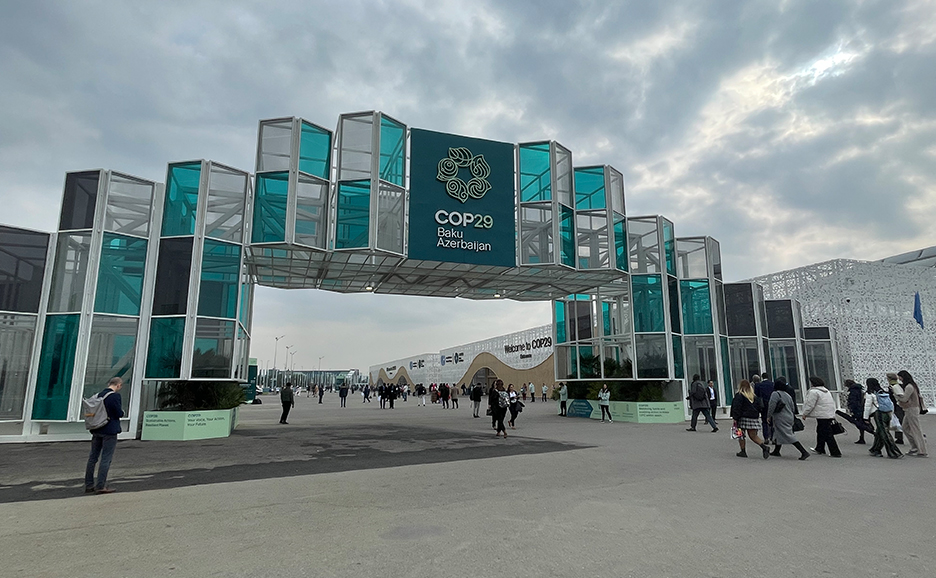How Fujitsu balances both priorities Solving societal issues or achieving business growth

Article | 2025-6-30
10 minute read
Fujitsu is promoting a Net Positive business approach, actively creating positive impacts on society and the environment through its corporate activities. Fujitsu’s Net Positive Index, independently researched and developed by Economist Impact, revealed that companies with a mature Net Positive approach demonstrate higher profitability and greater investor confidence. However, many companies struggle to fully realize Net Positive due to conflicts with other business priorities and organizational resistance. This article will showcase how Fujitsu has overcome these challenges, using specific initiatives as examples.
Net Positive is a concept that aims to go beyond reducing the negative impact of corporate activities in order to create a positive impact on society and the environment. Fujitsu believes that companies have a societal responsibility to pursue Net Positive at the same time as growing their businesses.
The Net Positive Index surveyed companies across 5 industries (financial services, manufacturing, mobility, retail and energy & utilities) in 17 countries in North America, Europe, and the Asia-Pacific region to find out how they are tackling Net Positive.
According to the Net Positive Index, companies across every industry with a sufficiently mature Net Positive approach were more likely to achieve revenue and market share targets and to gain investor confidence. This underscores the fact that pursuing Net Positive will benefit both business growth and society, as well as the environment. Despite the fact that many executives and decision makers understand the benefits of both, very few companies are truly Net Positive. While the factors vary, the most common internal challenges were “conflict with other business priorities (52.9%)” and “organizational resistance to change (46.4%)”.
How can companies overcome barriers within their organizations to promote Net Positive? In this article, Takashi Yamanishi, Corporate Executive Officer, EVP, CSSO (Chief Sustainability & Supply Chain Officer), will talk about Fujitsu's efforts to promote Net Positive and explain the value that Fujitsu can support customers’ efforts.
― First of all, please tell us about Fujitsu's Net Positive initiatives.
Yamanishi: Fujitsu defines Net Positive in the following way: “As a member of society, Fujitsu must address the materiality of solving global environmental problems, developing a digital society, and improving people’s well-being. We aim to maximize our impact on society through technology and innovation, along with making a positive financial impact on Fujitsu (monetary impact from our business activities).” We incorporate this thinking into company-wide strategies while at the same time, encouraging each business group to clarify its own materiality-related efforts and performance indicators in its business plans. They are, in turn, responsible for driving these efforts.
Specifically, we measure our impact on society and the environment, and the financial impact created by our efforts based on our approach to materiality: “solving global environmental issues,” “developing a digital society,” and “improving people's well-being,” with the aim of making both impacts positive.
When undertaking a Net Positive initiative, it is important to understand the current position of your company by visualizing the positive and negative impacts on your business, environment and society. Against this backdrop, we can help maximize positive impacts and minimize negative impacts to enhance the maturity of Net Positive.

― How do you measure the impact of your Net Positive efforts?
Yamanishi: Financial impact measures the monetary effect of our business activities associated with each materiality imperative. The impact on society and the environment is measured by setting indicators for each area of materiality.
For example, in the area of solving global environmental problems, we aggregate GHG (greenhouse gas) emissions from our business activities and supply chains as negative impact indicators, and the performance of our offerings and solutions that reduce our customers’ GHG emissions as positive impact indicators.
Since each indicator uses a different scale, we aim to maximize both the social and environmental impact and the financial impact without calculating all items on the same basis. As for the impact on society and the environment, there are many items for which there is no mechanism or method for measuring them, which creates some difficulties, but we are starting with the things that can be measured.
― What are some specific examples of Fujitsu's efforts to maximize positive impact and minimize negative impact?
Yamanishi: Specific examples of activities aimed at maximizing positive impact include reducing the digital divide through the provision of IT services and educational opportunities, assisting in the development of digital human resources, and developing technologies that contribute to solving environmental and societal issues. Fujitsu Uvance's support for the Sustainability Transformation of its customers also leads to a greater positive impact.
To minimize negative impacts, we are taking steps such as working to reduce GHG emissions by making our products more energy-efficient, and expanding the use of renewable energy. Technological developments to enhance information security and privacy protection will also reduce the negative impact. Furthermore, it is important to ensure compliance with procurement, respect for human rights, and improvements in working environments throughout the supply chain.
― The Net Positive Index found that “conflict with other business priorities” was a barrier to becoming Net Positive in many companies. Did Fujitsu also have this problem?
Yamanishi: Through Fujitsu Uvance, we have incorporated the realization of Net Positive into our corporate strategy as we aim to contribute to solving societal issues. We also believe that achieving Fujitsu Uvance's business goals will create positive societal and environmental impacts, so there will be no conflict.
However, the IT infrastructure and AI services we provide involve power consumption, which also creates negative environmental impacts such as GHG emissions. To minimize this, we are investing in improving the power efficiency of hardware products and developing power-saving technologies for AI data centers.
― The Net Positive Index also found that companies with larger numbers of employees have stronger organizational resistance to change, which is a barrier to promoting Net Positive. How is Fujitsu dealing with this challenge?
Yamanishi: We have a Sustainability Management Committee, of which I am the Executive Director, while our President and CEO serves as the chairperson. We have been actively discussing our Company's sustainability management as the key topic. Additionally, we hold in-house seminars together with business groups to enrich each employee’s understanding of the relationship between their business and materiality—and to be aware of their own contributions towards materiality. We will also be launching an in-house award system to honor contributions to materiality. Finally, we have been sharing information on internal communication platforms, providing educational content, and issuing Fujitsu-branded Open Badges, which commemorate certain achievements. Through these efforts, we are bolstering understanding while establishing a materiality-based business.
― Finally, what is your message for companies that are working on Net Positive?
Promoting Net Positive requires strengthening relationships with stakeholders, enacting changes throughout the entire value chain, and taking a long-term view of results. At Fujitsu, we will be accelerating our efforts to achieve Net Positive and provide this information to customers as a reference, thereby contributing to sustainability for customers and society. My advice would be: why not start by first understanding where your own company stands?
Notes:
- Fujitsu's 'Advancing Net Positive Agenda’, independently developed and researched by Economist Impact, is a first-of-its-kind toolkit to help business leaders understand and progress towards Net Positive. It includes the Net Positive Index, an action-oriented benchmark of where companies within five industries are on their journey to become Net Positive, and the Net Positive Assessment Tool, which allows companies to assess where they are in their Net Positive journey.
- Fujitsu’s Net Positive approach to sustainability management is to achieve a positive impact on society as a whole through technology and innovation, as well as a positive financial impact for our company. In order to achieve this goal, we are incorporating it into our corporate strategy, business strategies, and business plans, and measuring it according to our materiality criteria.
Takashi Yamanishi
EVP CSSO (Chief Sustainability & Supply Chain Officer), Fujitsu Limited
Takashi Yamanishi joined Fujitsu in 1989, with his primary focus being procurement from global vendors in areas such as software and semiconductors. He oversaw the global integration of procurement and supply chain management organizations as General Manager of the Global Supply Chain Division in 2018. Afterwards, in parallel with the shift to services within the business portfolio, he helped strengthen alliances with key partners while reforming procurement and supply chains. He assumed his current position in 2024.

Are you Net Positive ready?
Discover how your organization is advancing toward a thriving, Net Positive future.


Related Information
Data is essential in promoting a net positive approach

COP 29: Accelerating Green Action with Digital Technology

